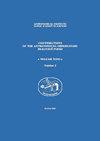大质量恒星的高对比度成像:QZ Car的例子
IF 0.2
4区 物理与天体物理
Q4 ASTRONOMY & ASTROPHYSICS
Contributions of the Astronomical Observatory Skalnate Pleso
Pub Date : 2020-03-01
DOI:10.31577/caosp.2020.50.2.590
引用次数: 0
摘要
大质量恒星的形成仍然是当今天体物理学中最有趣的问题之一。已经提出了几种形成理论,这些理论可以通过其结果的多样性特性进行潜在的测试。然而,观测方面的挑战使我们无法区分不同的形成场景:大质量恒星非常罕见,而且发现于距离我们相对较远的地方,它们在短时间内形成,并在它们诞生的富含气体的环境中在多个恒星系统中演化。利用VLT/SPHERE的极端自适应光学能力,我们观测了70多颗星系O型星,其中约一半在船底座星云中,另一半在星系场或星团和联合中,旨在表征它们的多重特性。SPHERE提供了前所未有的成像对比,使我们能够探测到大质量恒星周围最微弱的伴星。在这里,我们通过关注高阶多系统QZ Car来说明它的功能。本文章由计算机程序翻译,如有差异,请以英文原文为准。
High-contrast imaging of massive stars: the example of QZ Car
The formation of massive stars remains one of the most intriguing questions in astrophysics today. Several formation theories, that could potentially be tested by the multiplicity properties of their outcome, have been proposed. There are, however, observational challenges preventing us from discriminating between the different formation scenarios: massive stars are rare and found at relative large distances from us, they form on short timescales and evolve in multiple stellar systems within the gas-rich environment from which they are born. Taking advantage of the extreme-adaptive optics capabilities of VLT/SPHERE, we observed more than 70 galactic O stars, about half in the Carina nebula and another half in the galactic field or clusters and associations, aiming at characterizing their multiplicity properties. SPHERE offers unprecedented imaging contrasts which allows us to detect even the faintest companions around massive stars. Here, we illustrate its capabilities by focussing on the high-order multiple system QZ Car.
求助全文
通过发布文献求助,成功后即可免费获取论文全文。
去求助
来源期刊
CiteScore
1.10
自引率
20.00%
发文量
4
审稿时长
>12 weeks
期刊介绍:
Contributions of the Astronomical Observatory Skalnate Pleso" (CAOSP) is published by the Astronomical Institute of the Slovak Academy of Sciences (SAS). The journal publishes new results of astronomical and astrophysical research, preferentially covering the fields of Interplanetary Matter, Stellar Astrophysics and Solar Physics. We publish regular papers, expert comments and review contributions.

 求助内容:
求助内容: 应助结果提醒方式:
应助结果提醒方式:


